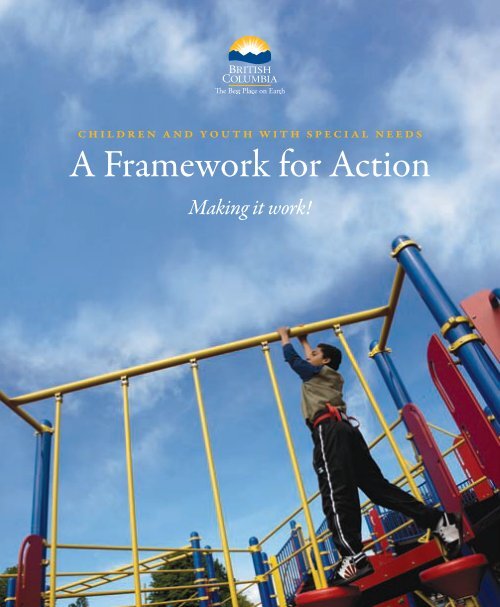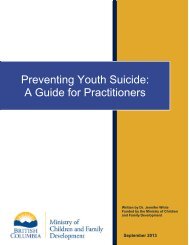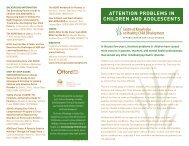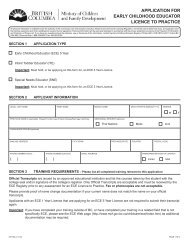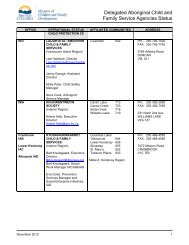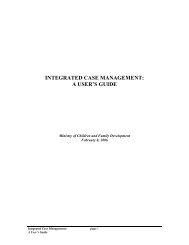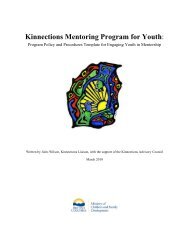A Framework for Action - Ministry of Children and Family Development
A Framework for Action - Ministry of Children and Family Development
A Framework for Action - Ministry of Children and Family Development
You also want an ePaper? Increase the reach of your titles
YUMPU automatically turns print PDFs into web optimized ePapers that Google loves.
<strong>Children</strong> <strong>and</strong> Youth with SpeCial needS<br />
A <strong>Framework</strong> <strong>for</strong> <strong>Action</strong><br />
Making it work!
librarY <strong>and</strong> arChiveS Canada Cataloguing in publiCation<br />
<strong>Children</strong> <strong>and</strong> youth with special needs : a framework <strong>for</strong> action.<br />
Co-published by <strong>Ministry</strong> <strong>of</strong> Health Services, <strong>Ministry</strong> <strong>of</strong> Education, <strong>and</strong><br />
<strong>Ministry</strong> <strong>of</strong> <strong>Children</strong> <strong>and</strong> <strong>Family</strong> <strong>Development</strong>.<br />
ISBN 978-0-7726-6053-4<br />
1. <strong>Children</strong> with disabilities–Services <strong>for</strong>–British Columbia. 2. Youth with disabilities–Services <strong>for</strong>–British Columbia. 3. <strong>Children</strong> with<br />
disabilities–Government policy–British Columbia. 4. Youth with disabilities–Government policy–British Columbia. I. British Columbia.<br />
<strong>Ministry</strong> <strong>of</strong> Education II. British Columbia. <strong>Ministry</strong> <strong>of</strong> Health III. British Columbia. <strong>Ministry</strong> <strong>of</strong> <strong>Children</strong> <strong>and</strong> <strong>Family</strong> <strong>Development</strong><br />
HV890.C32B76 2008 362.4’04809711 C2008-906363-5
Table <strong>of</strong> ConTenTs<br />
Ministers’ Letter ........................<br />
PurPose oF the FraMework ................<br />
Underst<strong>and</strong>ing Special Needs ....................<br />
where we want to be<br />
Vision ...................................<br />
Mission ..................................<br />
Goals<br />
how we get there ........................<br />
Values, Guiding Principles<br />
Six Strategies <strong>for</strong> <strong>Action</strong> ..........................<br />
Four tiers oF exPertise ...................<br />
Tier 1<br />
Tier 2<br />
Tier 3<br />
Tier 4<br />
strategies <strong>and</strong> aCtions For suCCess<br />
Goal: Improved Access<br />
Goal: Effective Services ........................<br />
Goal: Coherent Systems<br />
your roLe in iMPLeMenting the FraMework ..<br />
At The Community level .......................<br />
At The Regional level<br />
.....................<br />
...................................<br />
......................<br />
...................................<br />
...................................<br />
...................................<br />
...................................<br />
........<br />
........................<br />
.......................<br />
.........................<br />
At The Provincial level ........................<br />
What We Can All Do .........................<br />
Moving Forward .........................<br />
notes ..................................<br />
16<br />
2<br />
4<br />
4<br />
5<br />
5<br />
5<br />
5<br />
6<br />
6<br />
7<br />
8<br />
8<br />
8<br />
8<br />
9<br />
10<br />
10<br />
11<br />
12<br />
13<br />
13<br />
13<br />
13<br />
14<br />
15<br />
“<strong>Children</strong> <strong>and</strong><br />
youth with special<br />
needs <strong>and</strong> their<br />
families require a<br />
clear <strong>and</strong> continuous<br />
pathway to services<br />
that will meet their<br />
individual needs. I<br />
am encouraged by<br />
this collective<br />
commitment to<br />
achieving higher<br />
quality outcomes<br />
through more<br />
effective change.”<br />
Cindy Frostad, Parent
“The CYSN framework<br />
establishes a new<br />
paradigm <strong>for</strong><br />
ministries in the<br />
BC government to<br />
integrate <strong>and</strong><br />
co-ordinate ef<strong>for</strong>ts<br />
on behalf <strong>of</strong> children<br />
<strong>and</strong> their families. It<br />
should also serve us<br />
well as a model <strong>of</strong> best<br />
practice in establishing<br />
a new approach to<br />
health <strong>and</strong> wellness <strong>for</strong><br />
all children <strong>and</strong> youth<br />
in British Columbia.”<br />
dr. robert Peterson,<br />
direCtor, ChiLd heaLth bC<br />
MinisTers’ leTTer<br />
We are pleased to present the <strong>Children</strong> <strong>and</strong> Youth with<br />
Special Needs (CYSN) <strong>Framework</strong> <strong>for</strong> <strong>Action</strong>, British<br />
Columbia’s strategy to improve access, quality <strong>and</strong><br />
coordination <strong>of</strong> services <strong>for</strong> children <strong>and</strong> youth with<br />
special needs.<br />
The <strong>Framework</strong> provides a foundation <strong>for</strong> coordinated,<br />
collaborative action among people working in the health,<br />
education <strong>and</strong> social service sectors in B.C., <strong>and</strong> a plat<strong>for</strong>m<br />
<strong>of</strong> common values, principles <strong>and</strong> overarching strategies to<br />
guide the work.<br />
It recognizes the need to simplify <strong>and</strong> streamline the<br />
current array <strong>of</strong> services so it is easier <strong>for</strong> families to find<br />
in<strong>for</strong>mation <strong>and</strong> access services.<br />
It also provides an opportunity to build on our strengths<br />
<strong>and</strong> the excellent work already taking place in B.C.<br />
Participation <strong>and</strong> action from all sectors <strong>and</strong> from<br />
families will be required to help us reach the goal <strong>of</strong> better<br />
supporting children <strong>and</strong> youth with special needs in B.C.<br />
We encourage you to discuss the <strong>Framework</strong> <strong>and</strong> consider<br />
how it can be used in your own community.<br />
We also encourage you to share your stories, experiences<br />
<strong>and</strong> feedback as we move <strong>for</strong>ward with implementation<br />
across the province.<br />
2 <strong>Children</strong> <strong>and</strong> Youth with Special Needs – A <strong>Framework</strong> <strong>for</strong> <strong>Action</strong>
Together, we are embarking on an exciting <strong>and</strong> important<br />
step towards building the best system <strong>of</strong> support in<br />
Canada <strong>for</strong> children <strong>and</strong> youth with special needs.<br />
We look <strong>for</strong>ward to working with, <strong>and</strong> hearing from you.<br />
We are confident that through our shared commitment<br />
<strong>and</strong> partnerships, we can strengthen service delivery <strong>and</strong><br />
help improve the lives <strong>of</strong> B.C.’s children <strong>and</strong> youth with<br />
special needs <strong>and</strong> their families.<br />
honourable tom Christensen<br />
Minister oF ChiLdren <strong>and</strong> FaMiLy deveLoPMent<br />
honourable shirley bond<br />
Minister oF eduCation <strong>and</strong> Minister resPonsibLe For<br />
earLy Learning <strong>and</strong> LiteraCy<br />
honourable george abbott<br />
Minister oF heaLth serviCes<br />
<strong>Children</strong> <strong>and</strong> Youth with Special Needs – A <strong>Framework</strong> <strong>for</strong> <strong>Action</strong><br />
3
“The CYSN<br />
<strong>Framework</strong> <strong>for</strong> <strong>Action</strong><br />
sets the foundation <strong>for</strong><br />
the seamless delivery<br />
<strong>of</strong> services <strong>for</strong> children<br />
<strong>and</strong> youth with<br />
special needs <strong>and</strong> their<br />
families in British<br />
Columbia. Parents <strong>and</strong><br />
families will know how<br />
to access services <strong>for</strong><br />
their children from the<br />
health, education <strong>and</strong><br />
social service sectors.”<br />
bruCe s<strong>and</strong>y, ProvinCiaL<br />
advoCate bC assoCiation<br />
oF ChiLd deveLoPMent &<br />
intervention (bCaCdi)<br />
PurPose <strong>of</strong> The fraMework<br />
Families have been clear that they need in<strong>for</strong>mation, as well<br />
as access to quality services to help ensure their children with<br />
special needs have optimal opportunities <strong>for</strong> development,<br />
health, well-being <strong>and</strong> achievement.<br />
This <strong>Framework</strong> is B.C.’s strategy <strong>for</strong> improving the system <strong>of</strong><br />
support <strong>for</strong> children <strong>and</strong> youth with special needs <strong>and</strong> their<br />
families. It is intended to provide a common reference on which<br />
to plan ongoing strategic work.<br />
The CYSN <strong>Framework</strong> <strong>for</strong> <strong>Action</strong> includes a set <strong>of</strong> values <strong>and</strong><br />
strategies to guide collaborative work among health, education<br />
<strong>and</strong> social service sectors in the creation <strong>of</strong> an integrated,<br />
accessible continuum <strong>of</strong> quality services <strong>for</strong> children <strong>and</strong> youth<br />
with special needs <strong>and</strong> their families.<br />
Commitment <strong>and</strong> concerted action is required <strong>for</strong> this to work.<br />
We need to coordinate ef<strong>for</strong>ts, learn from others, <strong>and</strong> share<br />
expertise <strong>and</strong> resources.<br />
As we implement the <strong>Framework</strong>, it is our collaboration that<br />
will ultimately improve services <strong>and</strong> access <strong>for</strong> children, youth<br />
<strong>and</strong> families.<br />
School districts, health authorities, service providers, families<br />
<strong>and</strong> the Ministries <strong>of</strong> Education, <strong>Children</strong> <strong>and</strong> <strong>Family</strong><br />
<strong>Development</strong> <strong>and</strong> Health Services all have a role to play.<br />
Working together we can make a difference!<br />
underst<strong>and</strong>ing sPeCiaL needs<br />
For this <strong>Framework</strong>, the term children <strong>and</strong> youth with special<br />
needs refers to children <strong>and</strong> youth up to 19 years <strong>of</strong> age who<br />
require significant additional educational, medical/health <strong>and</strong><br />
social/environmental support – beyond that required by children<br />
in general – to enhance or improve their health, development,<br />
learning, quality <strong>of</strong> life, participation <strong>and</strong> community inclusion.<br />
4 <strong>Children</strong> <strong>and</strong> Youth with Special Needs – A <strong>Framework</strong> <strong>for</strong> <strong>Action</strong>
where we wanT To be<br />
vision<br />
Optimal development, health, well-being <strong>and</strong> achievement <strong>for</strong><br />
children <strong>and</strong> youth with special needs.<br />
Mission<br />
To promote <strong>and</strong> deliver accessible, high-quality intervention <strong>and</strong><br />
support services <strong>for</strong> children <strong>and</strong> youth with special needs <strong>and</strong><br />
their families, through an integrated service delivery approach.<br />
goaLs<br />
Improved access – The right services at the right time<br />
Effective services – High-quality services with strong evaluation<br />
Coherent systems – Improved integration <strong>and</strong> coordination<br />
<strong>Children</strong> <strong>and</strong> Youth with Special Needs – A <strong>Framework</strong> <strong>for</strong> <strong>Action</strong><br />
5<br />
“Educators across<br />
this province applaud<br />
the collaborative<br />
approach outlined in<br />
this <strong>Framework</strong>. It puts<br />
children first, <strong>and</strong> clearly<br />
identifies strategies<br />
<strong>for</strong> success.”<br />
geoFF JoPson, Past-President,<br />
bC sChooL suPerintendents’<br />
assoCiation
how we geT There<br />
vaLues <strong>and</strong> guiding PrinCiPLes<br />
Common values <strong>and</strong> principles are key elements <strong>of</strong> the <strong>Framework</strong><br />
<strong>and</strong> are used to in<strong>for</strong>m <strong>and</strong> guide thinking <strong>and</strong> planning.<br />
Th ey provide the foundation <strong>for</strong> service planning <strong>and</strong> service<br />
delivery. Th e service system <strong>for</strong> children <strong>and</strong> youth with special<br />
needs should be:<br />
• Integrated <strong>and</strong> comprehensive<br />
• Accessible<br />
• Child-centred <strong>and</strong> family-focused<br />
• Functionally-based<br />
• Evidence-based<br />
• Culturally competent <strong>and</strong> safe<br />
• Responsive to change<br />
• Fair <strong>and</strong> equitable<br />
• Evaluated<br />
• Sustainable<br />
6 <strong>Children</strong> <strong>and</strong> Youth with Special Needs – A <strong>Framework</strong> <strong>for</strong> <strong>Action</strong>
six strategies For aCtion<br />
The following strategies are the cornerstones <strong>of</strong> the <strong>Framework</strong>.<br />
They are intended to guide collaborative work, frame discussions<br />
<strong>and</strong> planning, provide a practical approach to organizing<br />
activities, <strong>and</strong> support the identification <strong>of</strong> priorities.<br />
Strategy 1: Placing children’s <strong>and</strong> families’ needs first<br />
Functionally-based <strong>and</strong> accessible services<br />
Strategy 2: Supporting our people<br />
Training, recruitment <strong>and</strong> retention<br />
Strategy 3: Ensuring quality <strong>and</strong> per<strong>for</strong>mance<br />
Improving quality measurement <strong>and</strong> accountability<br />
Strategy 4: Building <strong>and</strong> using the evidence base<br />
Promoting evaluation <strong>and</strong> research<br />
Strategy 5: Simplifying the pathway to services<br />
Providers, agencies <strong>and</strong> ministries coordinating,<br />
collaborating <strong>and</strong> integrating<br />
Strategy 6: Planning together<br />
Instituting a province-wide integrated<br />
planning mechanism<br />
<strong>Children</strong> <strong>and</strong> Youth with Special Needs – A <strong>Framework</strong> <strong>for</strong> <strong>Action</strong><br />
7
“This <strong>Framework</strong><br />
will help us to better<br />
coordinate services <strong>and</strong><br />
share successes together<br />
with the children <strong>and</strong><br />
families we work with.”<br />
diana eLLiott, ProvinCiaL<br />
advisor, aboriginaL inFant<br />
deveLoPMent PrograMs<br />
four Tiers <strong>of</strong> exPerTise<br />
In the CYSN <strong>Framework</strong> <strong>for</strong> <strong>Action</strong>, the service delivery<br />
system is organized into tiers representing the many layers<br />
<strong>of</strong> expertise available to children, youth <strong>and</strong> families. This is<br />
based on a model which has been used successfully in other<br />
countries to help reduce gaps <strong>and</strong> overlaps in service, <strong>and</strong><br />
increase collaboration between service providers.<br />
tier 1<br />
Tier 1 providers have a great breadth <strong>of</strong> knowledge <strong>and</strong><br />
provide general services which are available to all children<br />
<strong>and</strong> families in B.C.<br />
This group includes public health nurses, family doctors,<br />
social workers, <strong>and</strong> teachers. Tier 1 providers play an<br />
important role in the identification <strong>of</strong> special needs, <strong>and</strong> may<br />
have a role in screening, referrals <strong>and</strong> supporting families.<br />
tier 2<br />
Tier 2 providers are the “home team” <strong>for</strong> children <strong>and</strong> youth<br />
with special needs <strong>and</strong> their families. They are specialized<br />
community-based service providers who have significant<br />
knowledge <strong>and</strong> experience in child development <strong>and</strong> disability.<br />
This group includes infant development consultants,<br />
supported child development consultants, key workers,<br />
paediatricians, psychologists, occupational therapists,<br />
physiotherapists, speech language pathologists, <strong>and</strong> special<br />
education teachers.<br />
tier 3<br />
Tier 3 providers have an in-depth knowledge in a particular<br />
area <strong>and</strong> provide specialized regionally-based services.<br />
Examples in this group include the Complex <strong>Development</strong>al<br />
Behavioural Conditions assessment teams in regional health<br />
authorities <strong>and</strong> SET–BC (Special Education Technology<br />
British Columbia).<br />
8 <strong>Children</strong> <strong>and</strong> Youth with Special Needs – A <strong>Framework</strong> <strong>for</strong> <strong>Action</strong>
tier 4<br />
Tier 4 providers <strong>of</strong>fer provincial one-<strong>of</strong>-a-kind services not<br />
available in every community.<br />
Examples in this group include specialized teams at Sunny<br />
Hill Health Centre <strong>for</strong> <strong>Children</strong>, Provincial Services <strong>for</strong> the<br />
Deaf <strong>and</strong> Hard <strong>of</strong> Hearing, the Community Brain Injury<br />
Program <strong>and</strong> the Provincial Integrated Support Program <strong>for</strong><br />
students with severe/multiple disabilities.<br />
Tier Four<br />
Provincial Sub-specialized Special Needs Services<br />
Highly specialized <strong>and</strong> one <strong>of</strong> a kind<br />
(eg: Sunny Hill Inpatient Brain Injury Team)<br />
Tier Three<br />
Regional Specialized Special Needs Services<br />
Regionally-based<br />
(eg: CDBC Assessment Teams)<br />
Tier Two<br />
Community Special Needs Services<br />
“Home Team”<br />
(eg: Infant <strong>Development</strong> Consultants,<br />
Special Education Teachers <strong>and</strong> Paediatricians)<br />
Tier one<br />
“Broad-reaching” Service Providers<br />
General services, available to all<br />
(eg: Public Health Nurses, <strong>Family</strong> Doctors <strong>and</strong> Teachers)<br />
<strong>Children</strong> <strong>and</strong> Youth with Special Needs – A <strong>Framework</strong> <strong>for</strong> <strong>Action</strong><br />
9
“One <strong>of</strong> the most positive<br />
things I’ve seen come out<br />
<strong>of</strong> government in a long<br />
time. Parents win with<br />
this <strong>Framework</strong>.”<br />
aLanna hendren, exeCutive<br />
direCtor, deveLoPMentaL<br />
disabiLities assoCiation<br />
sTraTegies <strong>and</strong> aCTions<br />
<strong>for</strong> suCCess<br />
goaL: iMProved aCCess<br />
The right services at the right time<br />
strategy 1: Placing children’s <strong>and</strong> families’ needs first<br />
Enhancing services, aligning them to meet the real needs <strong>of</strong> children<br />
<strong>and</strong> youth with special needs <strong>and</strong> their families<br />
<strong>Action</strong>s<br />
• Strengthen the integration <strong>of</strong> services <strong>for</strong> children <strong>and</strong> youth<br />
with special needs across the health, education <strong>and</strong> social<br />
service sectors<br />
• Support the development <strong>of</strong> <strong>and</strong> access to a full range <strong>of</strong><br />
effective services that reflect <strong>and</strong> support Aboriginal cultures<br />
<strong>and</strong> traditions<br />
• Focus services on the functional needs <strong>of</strong> children, youth <strong>and</strong><br />
their families<br />
strategy 2: supporting our people<br />
Facilitating training, recruitment <strong>and</strong> retention <strong>of</strong> high quality,<br />
skilled service providers<br />
<strong>Action</strong>s<br />
• Enhance the capacity <strong>and</strong> expertise <strong>of</strong> those serving children<br />
<strong>and</strong> youth with special needs <strong>and</strong> their families through crosssectoral<br />
training <strong>and</strong> in<strong>for</strong>mation<br />
• Support recruitment <strong>of</strong> service providers with joint<br />
recruitment strategies, student initiatives, parapr<strong>of</strong>essional<br />
opportunities <strong>and</strong> a focus on rural areas<br />
• Support retention <strong>of</strong> service providers with pr<strong>of</strong>essional<br />
development, mentoring, training incentives <strong>and</strong><br />
technology-based resources<br />
10 <strong>Children</strong> <strong>and</strong> Youth with Special Needs – A <strong>Framework</strong> <strong>for</strong> <strong>Action</strong>
goaL: eFFeCtive serviCes<br />
High-quality services with strong evaluation<br />
strategy 3: ensuring quality <strong>and</strong> per<strong>for</strong>mance<br />
Improving quality measurement <strong>and</strong> accountability<br />
<strong>Action</strong>s<br />
• Use inter-ministry protocols so that services are provided in an<br />
accessible, underst<strong>and</strong>able <strong>and</strong> coordinated manner<br />
• Use a common quality framework <strong>and</strong> service quality<br />
indicators to improve per<strong>for</strong>mance <strong>and</strong> accountability across<br />
the health, education <strong>and</strong> social service sectors<br />
• Ensure an integrated approach across sectors to in<strong>for</strong>mation<br />
systems <strong>and</strong> in<strong>for</strong>mation management<br />
strategy 4: building <strong>and</strong> using the evidence base<br />
Promoting evaluation <strong>and</strong> research<br />
<strong>Action</strong>s<br />
• Support existing <strong>and</strong> new research related to children <strong>and</strong><br />
youth with special needs<br />
• Develop mechanisms <strong>for</strong> sharing <strong>and</strong> using evidence <strong>and</strong><br />
best practices<br />
• Identify opportunities to make new research underst<strong>and</strong>able to<br />
staff, service providers, <strong>and</strong> families across all sectors<br />
• Promote evaluation in the planning <strong>and</strong> development <strong>of</strong> services<br />
<strong>Children</strong> <strong>and</strong> Youth with Special Needs – A <strong>Framework</strong> <strong>for</strong> <strong>Action</strong><br />
11<br />
“After years <strong>of</strong> talking<br />
about it, something is<br />
actually happening.<br />
And it makes sense.<br />
It’s certainly the most<br />
exciting initiative I’ve<br />
seen in 35 years.”<br />
Jane hoLL<strong>and</strong>, advoCate<br />
For serviCe QuaLity
“It <strong>of</strong>fers promise <strong>of</strong> truly<br />
integrated, rational, <strong>and</strong><br />
better quality services.”<br />
CLare sChuMan, exeCutive<br />
direCtor aCt autisM<br />
CoMMunity training<br />
goaL: Coherent systeMs<br />
Improved integration <strong>and</strong> coordination<br />
strategy 5: simplifying the pathway to services<br />
Coordinating, collaborating <strong>and</strong> integrating among providers,<br />
agencies <strong>and</strong> ministries<br />
<strong>Action</strong>s<br />
• Identify <strong>and</strong> address cross-sectoral program duplications <strong>and</strong><br />
service gaps<br />
• Provide cross-sectoral in<strong>for</strong>mation to help families <strong>of</strong> children<br />
<strong>and</strong> youth with special needs access services more easily<br />
• Improve the coordination <strong>of</strong> services <strong>for</strong> families seeking or<br />
currently receiving services<br />
strategy 6: Planning together<br />
Instituting a province-wide integrated planning mechanism<br />
<strong>Action</strong>s<br />
• Coordinate regional <strong>and</strong> provincial planning among the<br />
three sectors<br />
• Jointly identify priorities<br />
• Share successful practices <strong>and</strong> knowledge<br />
• Use electronic collaboration <strong>and</strong> communication tools<br />
12 <strong>Children</strong> <strong>and</strong> Youth with Special Needs – A <strong>Framework</strong> <strong>for</strong> <strong>Action</strong>
Your role in iMPleMenTing<br />
The fraMework<br />
Whether you work at a community, regional or provincial<br />
level, you have a role to play in bringing this <strong>Framework</strong> to life.<br />
at the CoMMunity LeveL...<br />
Communities take into account the views, knowledge <strong>and</strong><br />
experience <strong>of</strong> a range <strong>of</strong> people <strong>and</strong> organizations – an<br />
important first step in planning effective action.<br />
It is at the community level, in all sectors, that the voices <strong>of</strong><br />
children <strong>and</strong> youth with special needs <strong>and</strong> their families are<br />
heard most directly.<br />
This is where families live <strong>and</strong> the child’s “home team” resides.<br />
Work at this level depends on the unique needs, strengths<br />
<strong>and</strong> capacities <strong>of</strong> each community, including the existing<br />
knowledge base, relationships, <strong>and</strong> current work underway<br />
relating to children <strong>and</strong> youth with special needs.<br />
at the regionaL LeveL...<br />
The role at the regional level is one <strong>of</strong> strategic planning,<br />
setting priorities, coordinating across sectors <strong>and</strong> with<br />
communities, <strong>and</strong> supporting implementation <strong>of</strong> regional<br />
<strong>and</strong> community initiatives.<br />
at the ProvinCiaL LeveL...<br />
Much <strong>of</strong> the activity at the provincial level focuses on strategic<br />
planning, development <strong>of</strong> implementation tools, collaborative<br />
policy development, developing <strong>and</strong> strengthening<br />
coordination across ministries, ensuring an integrated quality<br />
assurance approach <strong>and</strong> supporting the implementation <strong>of</strong><br />
regional <strong>and</strong> community initiatives.<br />
<strong>Children</strong> <strong>and</strong> Youth with Special Needs – A <strong>Framework</strong> <strong>for</strong> <strong>Action</strong><br />
13<br />
“The time has come to<br />
realize that one sector<br />
cannot do the work<br />
alone. This framework<br />
provides the impetus<br />
<strong>and</strong> opportunity <strong>for</strong><br />
“all <strong>of</strong> us” to truly<br />
collaborate, to ensure<br />
that the future <strong>for</strong><br />
children with special<br />
needs <strong>and</strong> their families<br />
is bright.”<br />
Laurie Meston, direCtor<br />
oF instruCtion, sChooL<br />
distriCt 42, <strong>and</strong> President,<br />
bC CounCiL oF adMinistrators<br />
oF sPeCiaL eduCation
“Wow! I am really<br />
impressed with the<br />
work done by the three<br />
ministries to provide a<br />
common framework <strong>for</strong><br />
all providers to work<br />
together in our support<br />
<strong>of</strong> children with special<br />
needs <strong>and</strong> their families.<br />
I am already using the<br />
framework in planning<br />
<strong>and</strong> reviewing programs<br />
<strong>and</strong> find it to be<br />
tremendously helpful.”<br />
robert (bob) arMstrong,<br />
head oF the ubC dePartMent<br />
oF PediatriCs <strong>and</strong> ChieF oF<br />
PaediatriC MediCine at the<br />
bC ChiLdren’s hosPitaL <strong>and</strong><br />
bC woMen’s hosPitaL <strong>and</strong><br />
heaLth Centre<br />
what we Can aLL do<br />
• Engage in discussions about services <strong>for</strong> children <strong>and</strong> youth<br />
with special needs, the CYSN <strong>Framework</strong> <strong>for</strong> <strong>Action</strong> <strong>and</strong><br />
its potential uses<br />
• Enlarge the circle <strong>of</strong> people <strong>and</strong> organizations that<br />
underst<strong>and</strong> the issues <strong>and</strong> are committed to<br />
developing solutions<br />
• Involve youth <strong>and</strong> families in discussions, planning<br />
<strong>and</strong> implementation<br />
• Establish, strengthen <strong>and</strong> support cross-sectoral provincial<br />
<strong>and</strong> regional planning tables, community coalitions<br />
<strong>and</strong> networks with a focus on children <strong>and</strong> youth with<br />
special needs<br />
• Promote effective partnerships, improve collaboration <strong>and</strong><br />
increase integration across sectors<br />
• Use the <strong>Framework</strong> to guide service planning <strong>and</strong> service<br />
delivery, with a focus on new <strong>and</strong> innovative practices<br />
• Use the <strong>Framework</strong>’s vision, mission, values <strong>and</strong> strategies<br />
to identify priorities <strong>for</strong> collaborative work<br />
• Share expertise, knowledge <strong>and</strong> strategic priorities across<br />
sectors <strong>and</strong> between regional, community <strong>and</strong><br />
provincial levels<br />
14 <strong>Children</strong> <strong>and</strong> Youth with Special Needs – A <strong>Framework</strong> <strong>for</strong> <strong>Action</strong>
Moving <strong>for</strong>ward<br />
While the idea <strong>of</strong> collaboration is not new to anyone involved<br />
in supporting children <strong>and</strong> youth with special needs <strong>and</strong> their<br />
families, the CYSN <strong>Framework</strong> <strong>for</strong> <strong>Action</strong> <strong>of</strong>fers a new way to<br />
collaborate. It provides a model <strong>for</strong> coordinating collective<br />
energy among the health, education <strong>and</strong> social service sectors<br />
<strong>and</strong> encourages us to work together as a seamless service<br />
delivery system.<br />
The <strong>Framework</strong> builds on the good work that is already taking<br />
place across B.C. <strong>and</strong> provides a focus <strong>for</strong> organizing current <strong>and</strong><br />
future activities. The strategies, principles <strong>and</strong> actions will frame<br />
our discussions <strong>and</strong> assist us as we move <strong>for</strong>ward.<br />
Communities, regional partners <strong>and</strong> provincial stakeholders are<br />
encouraged to use this document to guide all aspects <strong>of</strong> priority<br />
setting, actions, reporting, <strong>and</strong> evaluation.<br />
The power <strong>of</strong> cumulative action cannot be underestimated. With<br />
the leadership <strong>and</strong> passion <strong>of</strong> B.C.’s service providers, <strong>and</strong> the<br />
support <strong>and</strong> input <strong>of</strong> families, we can take the steps needed to<br />
create an integrated continuum <strong>of</strong> quality services <strong>for</strong> children<br />
<strong>and</strong> youth with special needs <strong>and</strong> their families.<br />
Do you have questions or ideas? Let us know by emailing:<br />
cysnframework@gov.bc.ca<br />
For more in<strong>for</strong>mation visit the following websites:<br />
<strong>Ministry</strong> <strong>of</strong> Education<br />
www.bced.gov.bc.ca/specialed<br />
<strong>Ministry</strong> <strong>of</strong> Health Services<br />
www.health.gov.bc.ca/library/publications<br />
<strong>Ministry</strong> <strong>of</strong> <strong>Children</strong> <strong>and</strong> <strong>Family</strong> <strong>Development</strong><br />
www.mcf.gov.bc.ca/spec_needs/<br />
<strong>Children</strong> <strong>and</strong> Youth with Special Needs – A <strong>Framework</strong> <strong>for</strong> <strong>Action</strong><br />
15
noTes
12/2008 4500192502


